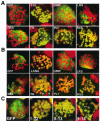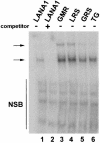The Kaposi's sarcoma-associated herpesvirus latency-associated nuclear antigen 1 N terminus is essential for chromosome association, DNA replication, and episome persistence
- PMID: 14671111
- PMCID: PMC303411
- DOI: 10.1128/jvi.78.1.294-301.2004
The Kaposi's sarcoma-associated herpesvirus latency-associated nuclear antigen 1 N terminus is essential for chromosome association, DNA replication, and episome persistence
Abstract
To persist in latently infected, proliferating cells, Kaposi's sarcoma-associated herpesvirus (KSHV) episomes must replicate and efficiently segregate to progeny nuclei. Episome persistence in uninfected cells requires latency-associated nuclear antigen 1 (LANA1) in trans and cis-acting KSHV terminal repeat (TR) DNA. The LANA1 C terminus binds TR DNA, and LANA1 mediates TR-associated DNA replication in transient assays. LANA1 also concentrates at sites of KSHV TR DNA episomes along mitotic chromosomes, consistent with a tethering role to efficiently segregate episomes to progeny nuclei. LANA1 amino acids 5 to 22 constitute a chromosome association region (Piolot et al., J. Virol. 75:3948-3959, 2001). We now investigate LANA1 residues 5 to 22 with scanning alanine substitutions. Mutations targeting LANA1 5GMR7, 8LRS10, and 11GRS13 eliminated chromosome association, DNA replication, and episome persistence. LANA1 mutated at 14TG15 retained the ability to associate with chromosomes but was partially deficient in DNA replication and episome persistence. These results provide genetic support for a key role of the LANA1 N terminus in chromosome association, LANA1-mediated DNA replication, and episome persistence.
Figures






Similar articles
-
The latency-associated nuclear antigen, a multifunctional protein central to Kaposi's sarcoma-associated herpesvirus latency.Future Microbiol. 2011 Dec;6(12):1399-413. doi: 10.2217/fmb.11.137. Future Microbiol. 2011. PMID: 22122438 Free PMC article. Review.
-
Kaposi's sarcoma-associated herpesvirus latency-associated nuclear antigen 1 mediates episome persistence through cis-acting terminal repeat (TR) sequence and specifically binds TR DNA.J Virol. 2001 Apr;75(7):3250-8. doi: 10.1128/JVI.75.7.3250-3258.2001. J Virol. 2001. PMID: 11238851 Free PMC article.
-
KSHV LANA1 binds DNA as an oligomer and residues N-terminal to the oligomerization domain are essential for DNA binding, replication, and episome persistence.Virology. 2004 Feb 20;319(2):225-36. doi: 10.1016/j.virol.2003.11.002. Virology. 2004. PMID: 14980483
-
Kaposi's Sarcoma-Associated Herpesvirus LANA-Adjacent Regions with Distinct Functions in Episome Segregation or Maintenance.J Virol. 2019 Mar 5;93(6):e02158-18. doi: 10.1128/JVI.02158-18. Print 2019 Mar 15. J Virol. 2019. PMID: 30626680 Free PMC article.
-
Kaposi's Sarcoma-Associated Herpesvirus Latency-Associated Nuclear Antigen: Replicating and Shielding Viral DNA during Viral Persistence.J Virol. 2017 Jun 26;91(14):e01083-16. doi: 10.1128/JVI.01083-16. Print 2017 Jul 15. J Virol. 2017. PMID: 28446671 Free PMC article. Review.
Cited by
-
The latency-associated nuclear antigen, a multifunctional protein central to Kaposi's sarcoma-associated herpesvirus latency.Future Microbiol. 2011 Dec;6(12):1399-413. doi: 10.2217/fmb.11.137. Future Microbiol. 2011. PMID: 22122438 Free PMC article. Review.
-
Kaposi's sarcoma-associated herpesvirus-encoded LANA recruits topoisomerase IIβ for latent DNA replication of the terminal repeats.J Virol. 2012 Sep;86(18):9983-94. doi: 10.1128/JVI.00839-12. Epub 2012 Jul 3. J Virol. 2012. PMID: 22761383 Free PMC article.
-
Regulation of the interaction between glycogen synthase kinase 3 and the Kaposi's sarcoma-associated herpesvirus latency-associated nuclear antigen.J Virol. 2005 Aug;79(16):10429-41. doi: 10.1128/JVI.79.16.10429-10441.2005. J Virol. 2005. PMID: 16051835 Free PMC article.
-
Recruitment of the de novo DNA methyltransferase Dnmt3a by Kaposi's sarcoma-associated herpesvirus LANA.Proc Natl Acad Sci U S A. 2006 Sep 26;103(39):14554-9. doi: 10.1073/pnas.0604469103. Epub 2006 Sep 18. Proc Natl Acad Sci U S A. 2006. PMID: 16983096 Free PMC article.
-
MLL1 is regulated by KSHV LANA and is important for virus latency.Nucleic Acids Res. 2021 Dec 16;49(22):12895-12911. doi: 10.1093/nar/gkab1094. Nucleic Acids Res. 2021. PMID: 34850113 Free PMC article.
References
-
- Ballestas, M. E., P. A. Chatis, and K. M. Kaye. 1999. Efficient persistence of extrachromosomal KSHV DNA mediated by latency-associated nuclear antigen. Science 284:641-644. - PubMed
-
- Bastien, N., and A. A. McBride. 2000. Interaction of the papillomavirus E2 protein with mitotic chromosomes. Virology 270:124-134. - PubMed
-
- Cesarman, E., P. S. Moore, P. H. Rao, G. Inghirami, D. M. Knowles, and Y. Chang. 1995. In vitro establishment and characterization of two acquired immunodeficiency syndrome-related lymphoma cell lines (BC-1 and BC-2) containing Kaposi's sarcoma-associated herpesvirus-like (KSHV) DNA sequences. Blood 86:2708-2714. - PubMed
-
- Chang, Y., E. Cesarman, M. S. Pessin, F. Lee, J. Culpepper, D. M. Knowles, and P. S. Moore. 1994. Identification of herpesvirus-like DNA sequences in AIDS-associated Kaposi's sarcoma. Science 266:1865-1869. - PubMed
Publication types
MeSH terms
Substances
Grants and funding
LinkOut - more resources
Full Text Sources

